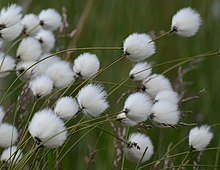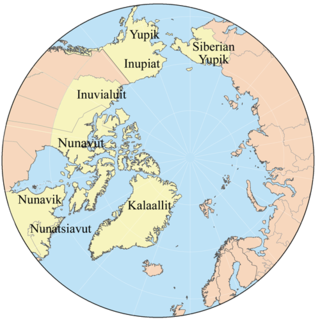
Eskimo is an exonym used to refer to two closely related Indigenous peoples: the Inuit and the Yupik of eastern Siberia and Alaska. A related third group, the Aleut, which inhabit the Aleutian Islands, are generally excluded from the definition of Eskimo. The three groups share a relatively recent common ancestor, and speak related languages belonging to the Eskaleut language family.

Sirmilik National Park is a national park located in Qikiqtaaluk, Nunavut, Canada, established in 1999. Situated within the Arctic Cordillera, the park is composed of three areas: most of Bylot Island with the exception for a few areas that are Inuit-owned lands, Kangiqłuruluk, and Baffin Island's Borden Peninsula. Much of the park is bordered by water.

Eriophorum angustifolium, commonly known as common cottongrass or common cottonsedge, is a species of flowering plant in the sedge family, Cyperaceae. Native to North America, North Asia, and Northern Europe, it grows on peat or acidic soils, in open wetland, heath or moorland. It begins to flower in April or May and, after fertilisation in early summer, the small, unremarkable brown and green flowers develop distinctive white bristle-like seed-heads that resemble tufts of cotton; combined with its ecological suitability to bog, these characteristics give rise to the plant's alternative name, bog cotton.

Sparganium (bur-reed) is a genus of flowering plants, described as a genus by Linnaeus in 1753. It is widespread in wet areas in temperate regions of both the Northern and Southern Hemispheres. The plants are perennial marsh plants that can grow to 3.5 m, with epicene flowers.

Hierochloe is a genus of plants in the grass family known generally as sweetgrass. These are perennial rhizomatous grasses found primarily in temperate and subarctic regions of Eurasia and North America, although some species extend southwards into Australia and Latin America.

Veratrum is a genus of flowering plants in the family Melanthiaceae. It occurs in damp habitats across much of temperate and subarctic Europe, Asia, and North America.
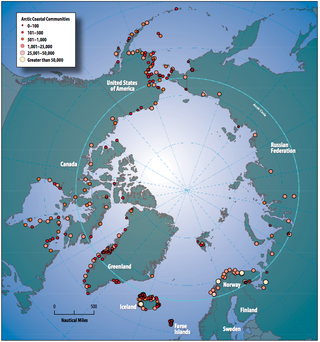
Circumpolar peoples and Arctic peoples are umbrella terms for the various indigenous peoples of the Arctic.

Kobresia is a genus of plants in the sedge family. They are sometimes called bog sedges. These perennial sedges are quite similar to Carex species in appearance. The genus is widespread across much of Europe, Asia and North America, with many species native to the Himalayas.

Oeneis jutta, the Jutta Arctic or Baltic grayling, is a species of butterfly in the subfamily Satyrinae with a Circumboreal distribution. It occurs in bogs and tundra in the north of Europe, the Baltic states, the Urals, Siberia, northern Kazakhstan, the Russian Far East, northern Mongolia, northeastern China, North Korea, and northern North America. Larvae feed on Carex and Eriophorum, possibly also Glyceria, Molinia, and Juncus. Ledum palustre is the preferred nectar plant of the adult butterflies. The species has one generation every one or two years, depending on the location.

Chamaenerion latifolium is a species of flowering plant in the evening primrose family known by the English common names dwarf fireweed and river beauty willowherb. It has a circumboreal distribution, appearing throughout the northern regions of the Northern Hemisphere, including subarctic and Arctic areas such as snowmelt-flooded gravel bars and talus, in a wide range of elevations. This is a perennial herb growing in clumps of leaves variable in size, shape, and texture above a woody caudex. The leaves are 1 to 10 centimeters long, lance-shaped to oval, pointed or rounded at the tips, and hairy to hairless and waxy. The inflorescence is a rough-haired raceme of nodding flowers with bright to deep pink, and occasionally white, petals up to 3 centimeters long. Behind the opened petals are pointed sepals. The fruit is an elongated capsule which may exceed 10 centimeters in length.
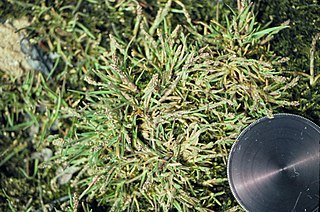
Phippsia is a genus of Arctic and alpine plants in the grass family.
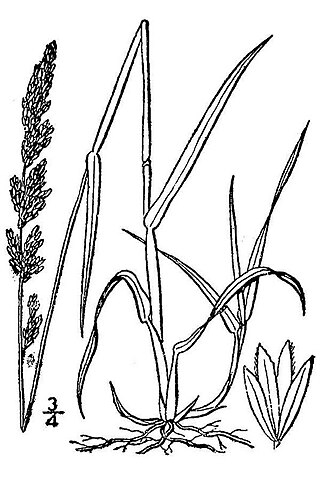
Arctagrostis is a genus of Arctic and Subarctic plants in the grass family, native to colder parts of Europe, Asia, and North America.

Dupontia is a genus of Arctic and Subarctic plants in the grass family.

Elachista serricornis is a moth of the family Elachistidae found in Europe.

Indigenous peoples of the Subarctic are the aboriginal peoples who live in the Subarctic regions of the Americas, Asia and Europe, located south of the true Arctic. This region includes the interior of Alaska, the Western Subarctic or western Canadian Shield and Mackenzie River drainage area, the Eastern Subarctic or Eastern Canadian Shield, Scandinavia, Western Russia and East Asia. Peoples of subarctic Siberia and Greenland are included in the subarctic; however, Greenlandic Inuit are usually classified as Indigenous peoples of the Arctic.

William Wyvill Fitzhugh IV is an American archaeologist and anthropologist who directs the Smithsonian’s Arctic Studies Center and is a Senior Scientist at the National Museum of Natural History. He has conducted archaeological research throughout the circumpolar region investigating cultural responses to climate and environmental change and European contact. He has published numerous books and more than 150 journal articles, and has produced large international exhibitions and popular films. Of particular note are the many exhibition catalogues he has had edited, which make syntheses of scholarly research on these subjects available to visitors to public exhibitions.

Eriophorum scheuchzeri is a species of flowering plant in the sedge family known by the common names Scheuchzer's cottongrass and white cottongrass. It has an arctic circumpolar and circumboreal distribution in the Northern Hemisphere. It can be found in Alaska, across Canada, in the Arctic islands, Greenland, Iceland, and across Eurasia. Disjunct occurrences exist in the Rocky Mountains, in the high mountains of southern Europe and on Mount Daisetsu in Japan and some other Asian mountains.
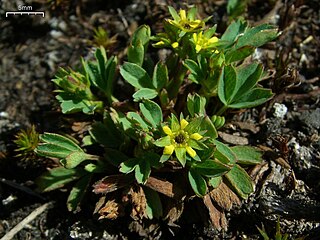
Sibbaldia is a genus of flowering plants of the family Rosaceae, with a circumpolar distribution, including the high Arctic. Most of the species are found in the Himalaya. The type species is Sibbaldia procumbens. It is also in the Rosoideae subfamily.
